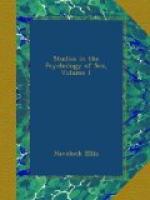The lives of all the great saints and mystics bear witness to operations similar to those so vividly described by Soeur Jeanne des Anges, though it is very rarely that any saint has so frankly presented the dynamic mechanism of the auto-erotic process. The indications they give us, however, are sufficiently clear. It is enough to refer to the special affection which the mystics have ever borne toward the Song of Songs,[405] and to note how the most earthly expressions of love in that poem enter as a perpetual refrain into their writings.[406]
The courage of the early Christian martyrs, it is abundantly evident, was in part supported by an exaltation which they frankly drew from the sexual impulse. Felicula, we are told in the acts of Achilles and Nereus,[407] preferred imprisonment, torture, and death to marriage or pagan sacrifices. When on the rack she was bidden to deny Christianity, she exclaimed: “Ego non nego amatorem meum!”—I will not deny my lover who for my sake has eaten gall and drunk vinegar, crowned with thorns, and fastened to the cross.
Christian mysticism and its sexual coloring was absorbed by the Islamic world at a very early period and intensified. In the thirteenth century it was reintroduced into Christendom in this intensified form by the genius of Raymond Lull who had himself been born on the confines of Islam, and his “Book of the Lover and the Friend” is a typical manifestation of sexual mysticism which inspired the great Spanish school of mystics a few centuries later. The “delicious agony” the “sweet martyrdom,” the strongly combined pleasure and pain experienced by St. Theresa were certainly associated with physical sexual sensations.[408]
The case of Marguerite-Marie Alacoque is typical. Jesus, as her autobiography shows, was always her lover, her husband, her dear master; she is betrothed to Him, He is the most passionate of lovers, nothing can be sweeter than His caresses, they are so excessive she is beside herself with the delight of them. The central imagination of the mystic consists essentially, as Ribot remarks, in a love romance.[409]
If we turn to the most popular devotional work that was ever written, The Imitation of Christ, we shall find that the “love” there expressed is precisely and exactly the love that finds its motive power in the emotions aroused by a person of the other sex. (A very intellectual woman once remarked to me that the book seemed to her “a sort of religious aphrodisiac.”) If we read, for instance, Book III, Chapter V, of this work ("De Mirabili affectu Divini amoris"), we shall find in the eloquence of this solitary monk in the Low Countries neither more nor less than the emotions of every human lover at their highest limit of exaltation. “Nothing is sweeter than love, nothing stronger, nothing higher, nothing broader, nothing pleasanter, nothing fuller nor better in heaven or in earth. He who loves, flies, runs, and rejoices; he is free and cannot be




